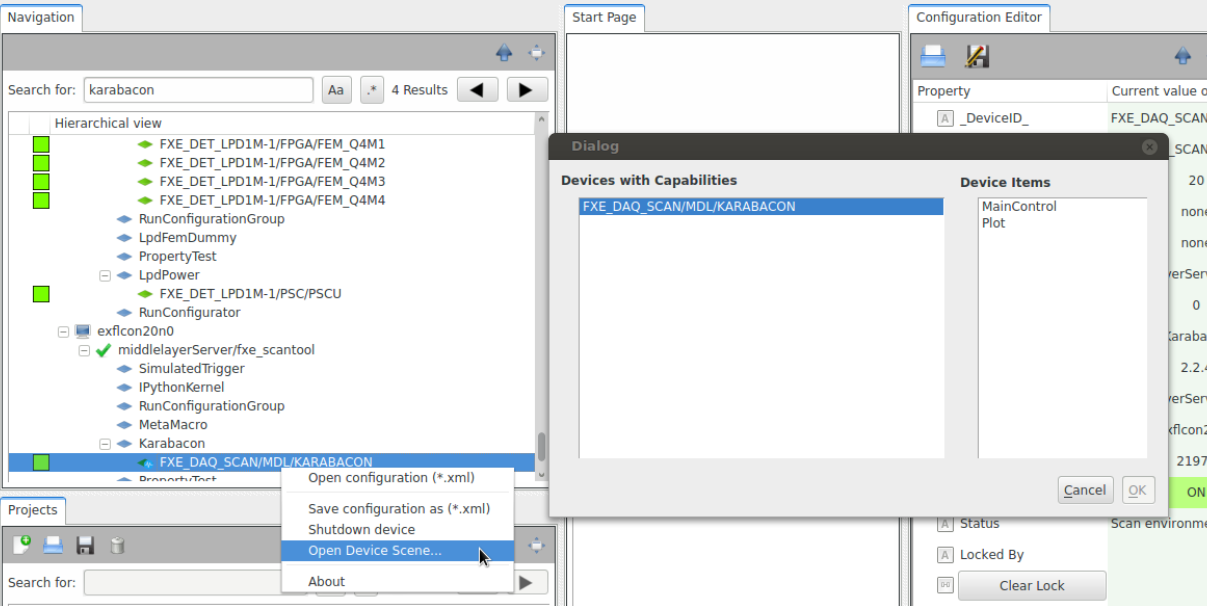Device Scenes¶
Karabo provides a protocol for devices to share predefined scenes. These allows the author of a device to provide what they think are a good starting point. Moreover, these are easily accessible by from the topology panel in the GUI:

A default scene can also be accessed by double-clicking on a device.
This section shows how to enable your device to have builtin scenes.
Implementing this functionality requires the creation of a scene, in the scene editor, conversion to Python, and adding the requestScene framework slot.
From scene to Python¶
Begin by drawing an adequate scene in the GUI’s scene editor, and save it locally on your computer as SVG (right-click on scene -> Save to File).
Use the karabo-scene2py utility to convert the SVG file to Python code:
$ karabo-scene2py scene.svg SA1_XTD2_UND/MDL/GAINCURVE_SCAN > scenes.py
The first argument is the scene file, the second is an optional deviceId to be substituted.
As it is generated code, make sure the file is PEP8 compliant. The final result should look more or less like the following:
from karabo.common.scenemodel.api import (
IntLineEditModel, LabelModel, SceneModel, write_scene
)
def get_scene(deviceId):
input = IntLineEditModel(height=31.0,
keys=['{}.config.movingAverageCount'.format(deviceId)],
parent_component='EditableApplyLaterComponent',
width=67.0, x=227.0, y=18.0)
label = LabelModel(font='Ubuntu,11,-1,5,50,0,0,0,0,0', foreground='#000000',
height=27.0, parent_component='DisplayComponent',
text='Running Average Shot Count',
width=206.0, x=16.0, y=15.0)
scene = SceneModel(height=1017.0, width=1867.0, children=[input, label])
return write_scene(scene)
Add this file to your device source project.
Providing the scene from your device¶
Add a read-only VectorString property called availableScenes to your expected parameters, and implement the requestScene framework slot. This is a predefined slot, which allows various actors to understand the scene protocol.
The slot takes a Hash params and returns a Hash with the origin, its datatype (deviceScene), and the scene itself:
from karabo.bound import DAQPolicy, VECTOR_STRING_ELEMENT
from karabo.common.api import KARABO_SCHEMA_DISPLAY_TYPE_SCENES as DT_SCENES
@staticmethod
def expectedParameters(expected):
(
VECTOR_STRING_ELEMENT(expected).key('availableScenes')
.setSpecialDisplayType(DT_SCENES)
.daqPolicy(DAQPolicy.OMIT)
.readOnly().initialValue(['overview'])
.commit()
)
def requestScene(self, params):
name = params.get('name', default='overview')
payload = Hash('success', True, 'name', name,
'data', get_scene(self.getInstanceId()))
self.reply(Hash('type', 'deviceScene',
'origin', self.getInstanceId(),
'payload', payload))
self.KARABO_SLOT(self.requestScene)
Providing several scenes from your device¶
Would you want to provide several scenes (e.g., overview and control scene), you can define several functions in scenes.py, and modify requestScene to check params[‘name’]:
from karabo.bound import DAQPolicy, VECTOR_STRING_ELEMENT
from karabo.common.api import KARABO_SCHEMA_DISPLAY_TYPE_SCENES as DT_SCENES
import .scenes
@staticmethod
def expectedParameters(expected):
(
VECTOR_STRING_ELEMENT(expected).key('availableScenes')
.setSepcialDisplayType(DT_SCENES)
.daqPolicy(DAQPolicy.OMIT)
.readOnly().initialValue(['overview', 'controls'])
.commit()
)
def requestScene(self, params):
payload = Hash('success', False)
name = params.get('name', default='overview')
if name == 'overview':
payload.set('success', True)
payload.set('name', name)
payload.set('data', scenes.overview(self.getInstanceId()))
elif name == 'controls':
payload.set('success', True)
payload.set('name', name)
payload.set('data', scenes.controls(self.getInstanceId()))
self.reply(Hash('type', 'deviceScene',
'origin', self.getInstanceId(),
'payload', payload))
self.KARABO_SLOT(self.requestScene)
Note
There is the convention that the default scene (of your choice) should be first in the availableScenes list.
Providing Table Elements¶
As described in table-element, table elements are vectors of hash, the schema is specified as Hash serialized to XML, (which karabo-scene2py takes care of).
In this case, it’s fine to break the PEP8 80 characters limit. A table element looks like:
table = TableElementModel(
column_schema='TriggerRow:<root KRB_Artificial="">CONTENT</root>',
height=196.0, keys=['{}.triggerEnv'.format(deviceId)],
klass='DisplayTableElement',
parent_component='DisplayComponent',
width=436.0, x=19.0, y=484.0
)
Linking To Other Devices Scenes¶
The following applies whether you want to link to another of your scenes or to another device’s scene.
Let’s say that you want to add links in your overview scene to your controls scene.
The DeviceSceneLinkModel allows you to specify links to other
dynamically provided scenes.
In your scenes.py, import DeviceSceneLinkModel and SceneTargetWindow from
karabo.common.scenemodel.api and extend overview(deviceId)():
from karabo.common.scenemodel.api import DeviceSceneLinkModel, SceneTargetWindow
def overview(deviceId):
# remaining scene stays the same
link_to_controls = DeviceSceneLinkModel(
height=40.0, width=314.0, x=114.0, y=227.0,
parent_component='DisplayComponent',
keys=['{}.availableScenes'.format(deviceId)], target='controls',
text='Controls scene',
target_window=SceneTargetWindow.Dialog)
children = [label, input, link_to_controls]
scene = SceneModel(height=1017.0, width=1867.0, children=children)
return write_scene(scene)
If you want to link to another device, make overview() accept another
remoteDeviceId parameter, and point the link to that device:
def overview(deviceId, remoteDeviceId):
# remaining scene stays the same
link_to_remote = DeviceSceneLinkModel(
height=40.0, width=314.0, x=114.0, y=267.0,
parent_component='DisplayComponent',
text='Link to other device',
keys=['{}.availableScenes'.format(remoteDeviceId)], target='scene',
target_window=SceneTargetWindow.Dialog
)
children = [label, input, link_to_controls, link_to_remote]
scene = SceneModel(height=1017.0, width=1867.0, children=children)
return write_scene(scene)
Reference Implementations¶
LimaCameras: provides a default scene with an image view in its LimaDevice
KEP21: definition of the scene protocol